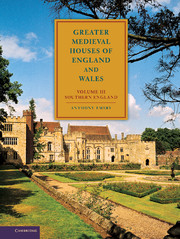Book contents
- Frontmatter
- Contents
- Acknowledgements
- List of abbreviations
- Introduction
- PART I THE THAMES VALLEY
- PART II LONDON AND SOUTH-EAST ENGLAND
- PART III SOUTH-WEST ENGLAND
- 14 South-west England: historical background
- 15 South-west England: architectural introduction
- 16 Secular art, decoration, and furnishing, 1300–1500
- 17 South-west England: bibliography
- 18 South-west England: survey
- Appendix 5 Castles of south-west England: residential additions
- Appendix 6 South-west England: residential licences to crenellate
- Appendix 7 The architectural value of John Leland and the Buck brothers
- List of plates
- List of figures
- Index
- Index of houses in volumes I, II and III
15 - South-west England: architectural introduction
from PART III - SOUTH-WEST ENGLAND
Published online by Cambridge University Press: 05 June 2012
- Frontmatter
- Contents
- Acknowledgements
- List of abbreviations
- Introduction
- PART I THE THAMES VALLEY
- PART II LONDON AND SOUTH-EAST ENGLAND
- PART III SOUTH-WEST ENGLAND
- 14 South-west England: historical background
- 15 South-west England: architectural introduction
- 16 Secular art, decoration, and furnishing, 1300–1500
- 17 South-west England: bibliography
- 18 South-west England: survey
- Appendix 5 Castles of south-west England: residential additions
- Appendix 6 South-west England: residential licences to crenellate
- Appendix 7 The architectural value of John Leland and the Buck brothers
- List of plates
- List of figures
- Index
- Index of houses in volumes I, II and III
Summary
DORSET is an appropriate introduction to the houses of south-west England, for with one key exception the early flourish of royal and episcopal castles in Wiltshire and Dorset was followed by almost total withdrawal from them. The ten stone castles in Wiltshire, led by the royal properties at Ludgershall, Marlborough, and Old Sarum and the episcopal fortresses within Old Sarum and at Devizes, Malmesbury and Downton were all in decay by 1350. Of the six stone castles in Dorset, only the dramatically sited royal fortress at Corfe and the early twelfth-century episcopal palace-fortress at Sherborne continued to be occupied throughout the middle ages. Building work at both sites had been completed before the close of the thirteenth century except for a tiered five-chamber tower added at Corfe Castle in 1377–8 which only survives at undercroft level, and some contemporarymodifications at Sherborne.
DEFENDABLE HOUSES
Our interest in Corfe Castle lies in the extremely important royal house built within the inner ward for King John in about 1201. Though badly ruined, its plan is relatively clear, but the region is particularly fortunate in possessing a second house for the same king at Cranborne. Despite its wholesale remodelling in the early seventeenth century which has converted this manor house into one of the most beautiful residences in southern England, the structure of c.1207 stands remarkably complete. These two houses, far earlier than any others surveyed in this volume, are of outstanding importance not only because of their early date and royal status, but because of the relative completeness of their plan and form and their relevance to regional developments up to 150 years later.
- Type
- Chapter
- Information
- Greater Medieval Houses of England and Wales, 1300–1500 , pp. 452 - 467Publisher: Cambridge University PressPrint publication year: 2006



